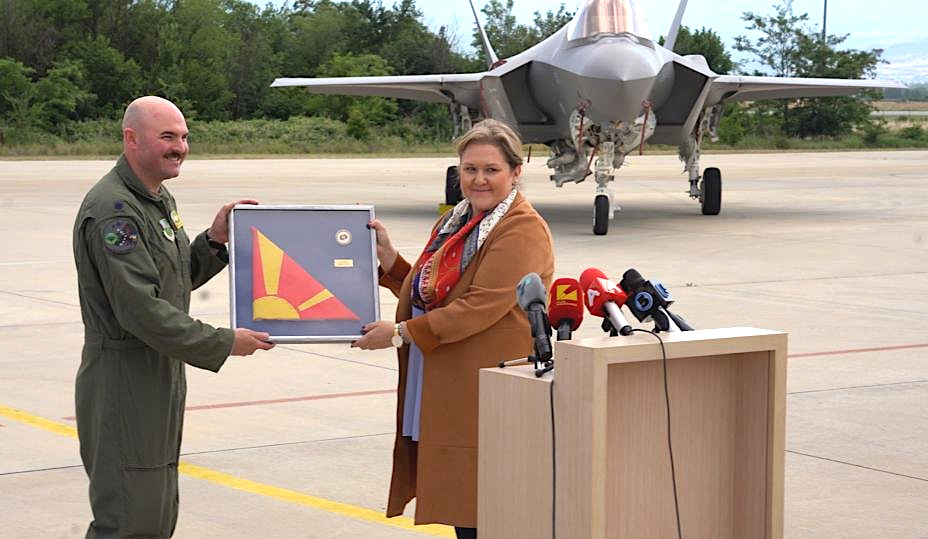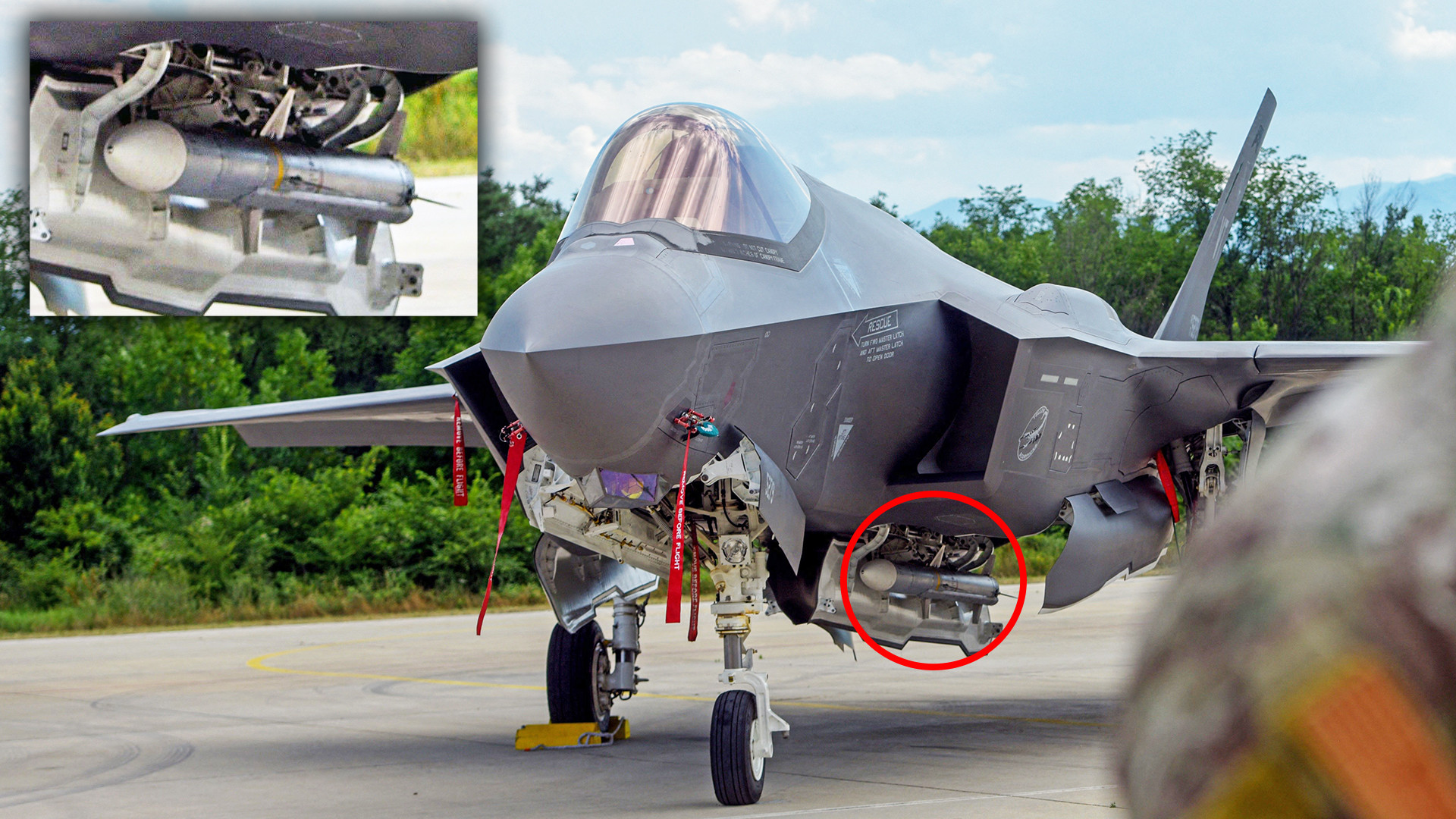A pair of F-35A Joint Strike Fighters from the Vermont Air National Guard touched down at Petrovec Military Airport near the city of Skopje, the capital of the eastern European country of North Macedonia, as part of an exercise earlier today. The jets are part of a contingent that has been forward-deployed to Spangdahlem Air Base in Germany since May to support NATO air policing requirements that have expanded in light of the conflict in Ukraine. They arrived at Petrovec armed with live AIM-120 Advanced Medium-Range Air-to-Air Missiles, or AMRAAMs.
The F-35As were both carrying a pair AIM-120s, one on each of their two internal bay doors. The missiles could be clearly identified as live rounds by the yellow band around the forward section of the body, which indicates the presence of a high explosive warhead. An additional two missiles were likely also housed in the bays themselves.
The visit to Petrovec by the two jets, both assigned to the Vermont Air National Guard 134th Fighter Squadron appears to be the first time Joint Strike Fighters of any kind have touched down in North Macedonia or any other country in the Balkans. U.S. Air Forces in Europe (USAFE), the Air Force’s top command in Europe, said the objective of sending the jets there today was to demonstrate Agile Combat Employment (ACE) concepts of operations and to reassure a NATO ally.
“The dynamic ACE construct enhances our ability to develop and employ resilient forces,” Air force Gen. Jeff Harrigian, head of USAFE, said in a statement. “Exercising ACE maneuvers also gives us the chance to improve interoperability with our allies, which enhances the strength and unity of NATO.”
The ACE concept focuses on the ability to deploy in irregular and unpredictable ways during contingencies and during routine activities. The goal is to be better able to deter potential adversaries during peacetime and to provide operational advantages and help reduce vulnerability during any actual conflict. In this particular instance, the Air Force demonstrated the ability to rapidly refuel and swap the pilots in the F-35As at Petrovec, which, in an actual combat scenario would be “designed to return the aircraft to the air quickly with fresh crews, extending the length and effectiveness of aerial missions,” according to the Air Force.
Armed with live AIM-120s, it very much appears that these two F-35As were still ready to perform their air policing duties if called upon. Despite the relatively mundane moniker, NATO air policing revolves around contingents of fully combat-capable fighter jets deployed at various bases that are ready to go on short notice to respond to any potential hostile air activity or other aerial emergencies, like hijackings, in and around the alliance’s collective airspace. Jets involved in the air policing mission also routinely train with other allied forces around their primary duties.
“It is because of North Macedonia’s membership as a NATO ally that we can share the security that comes from air policing missions and the rapid deployment of advanced capabilities of the F-35 platform as demonstrated today,” Air Force Lt. Col. John Macrae, a member of the Vermont Air National Guard who took part in today’s exercise, said during a press conference on the tarmac at Petrovec, as seen in the video below. “North Macedonia provides NATO air forces training and resources through Petrovec military airport and Krivolak training area that we need to maintain our readiness. And NATO air forces, in turn, have a chance to train alongside your air wing and army to ensure the present and future security of North Macedonia, the Balkan region, and Europe as a whole.”

The Vermont National Guard has had a formal relationship with the military of North Macedonia, which was known simply as Macedonia until 2019, since 1993 through the State Partnership Program. North Macedonia became a member of NATO in 2020.
“Operations of the F-35 from the airports in the Republic of North Macedonia is the most evident example of strategic partnership and mutual trust between the US and the Republic of North Macedonia,” Slavjanka Petrovska, the country’s Minister of Defense, said in a statement. “It shows our commitment and readiness to face unpredictable operational requirements in this complex international environment.”

At the moment, the complex international environment for North Macedonia, and the rest of NATO, very much centers on the conflict in Ukraine. Even before Russia’s all-out invasion of the country in Febraury, the United States and other NATO members were forward-deploying additional combat aircraft, as well as ground and naval forces, particularly along the alliance’s periphery with Russia, amid potential fears that the brewing crisis might spillover. This included a very public deployment of Air Force F-15C/D Eagle fighter jets, also armed with live AIM-120 missiles, to Łask Air Base in Poland.
So, while it is not necessarily surprising that F-35As currently deployed in Europe primarily to support the NATO air policing mission, the decision to arm these jets even for a non-combat trip to North Macedonia certainly underscores the alliance’s current heightened security posture. The Russian government has directed threats at NATO members, and the alliance as a whole, on multiple occasions since February over expanding deliveries of military aid and other assistance for Ukraine.

It’s also interesting to note that this comes just over a week after a still mysterious incident involving a small propeller-engined aircraft flying from Lithuania to Bulgaria, which borders North Macedonia to the west, without an approved flight plan. You can read more about what do know about that flight, which saw NATO fighter jets from the United States, Hungary, and Romania intercept and monitor the unidentified plane’s progress, here.
Incidents like this unexplained flight aside, the security posture across Europe has been all but irrevocably altered, at least for the foreseeable future, due to Russia’s war in Ukraine. The U.S. military and other NATO members have indicated that the alliance’s expanded force posture is likely to remain in place even after the conflict in Ukraine reaches some kind of resolution.
As such, NATO’s expanded air policing requirements look set to remain in place for years to come, which in turn means that fighter jets with live missiles may well become a more common sight at air bases and airports across the alliance.
Contact the author: joe@thedrive.com
